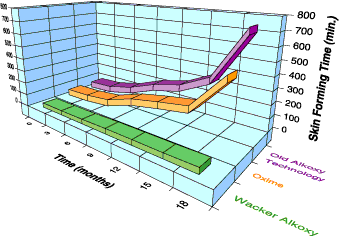Today, silicone sealants lead the market for permanently flexible construction sealants. This success is due to a range of products that were optimized for professional use in the building industry; in glazing, window, metal and plastics construction sectors; as well as for plumbing, kitchen and bathroom applications. Without them, many problems simply could not be solved.

Alkoxy Technology
Years of continuous research have culminated in the development of alkoxy systems, a new generation of neutral-curing silicone sealants that release an alcohol (methyl or ethyl) as they cure. Aimed at the building sector, they are intended for high-tech applications, window construction, and for sealing both indoor and outdoor joints.Sealant quality is derived from a large number of properties that contribute to the cured or end product’s overall performance and processing properties. Product developers tend to look for characteristics such as quality, adhesion and durability without deterioration (non-yellowing, high UV resistance, no embrittlement or cracking, and durability even under extreme climatic conditions).
Users attach importance to these factors as well. But they are also interested in processing properties, such as curing rate, low shrinkage, the absence of tailing that would otherwise necessitate cleanup, a low-odor level and long stability of the product in the cartridge.
The latest generation of neutral-cure systems offers the best of both worlds, and therefore represents a technological breakthrough. Up until now, alkoxy products had been unable to fulfill all the demands made on them – to the disadvantage of users. For instance, low orders of toxicity cannot make up for poor storage stability.
Wacker neutral-cure systems are state-of-the-art in terms of both end-product and processing properties. What is more, they offer specific advantages that are unique to alkoxy systems, and are also superior to conventional neutral-cure systems.
Processing Advantages of Neutral-Cure Systems:
- No primer needed
Specific Advantages of Uncured Wacker Alkoxy Systems:
- No paste tackiness, short tail
- Neutral odor
- Low orders of toxicity
Cured or End-Product Advantages of Neutral-Cure Systems:
- Optimum adhesion
- Durability and permanent flexibility
- UV resistance
- Resistance to moisture and temperature fluctuations
- Adheres well to painted substrates
Paintable Specific Advantages of Wacker Alkoxy Systems:
- Suitable for bonding polyacrylates and polycarbonates
- Non-corrosive towards mirrored surfaces
- High degree of transparency
The product range is designed to meet the requirements of different applications and substrates as well as all personal working styles. The products satisfy the specific demands of window construction, easily attaining the curing rates required for assembly and further processing of modules.
The range of applications for silicone sealants is extremely broad, and successful results depend on appropriate know-how.
For more information on ELASTOSIL® Alkoxy Neutral-Curing Silicone Sealants, contact Wacker Silicones Corp., 3301 Sutton Rd., Adrian, MI 49221-9397; phone 800-249-2491; fax 517-264-8620; or visit the Web site www.wackersilicones.com.

